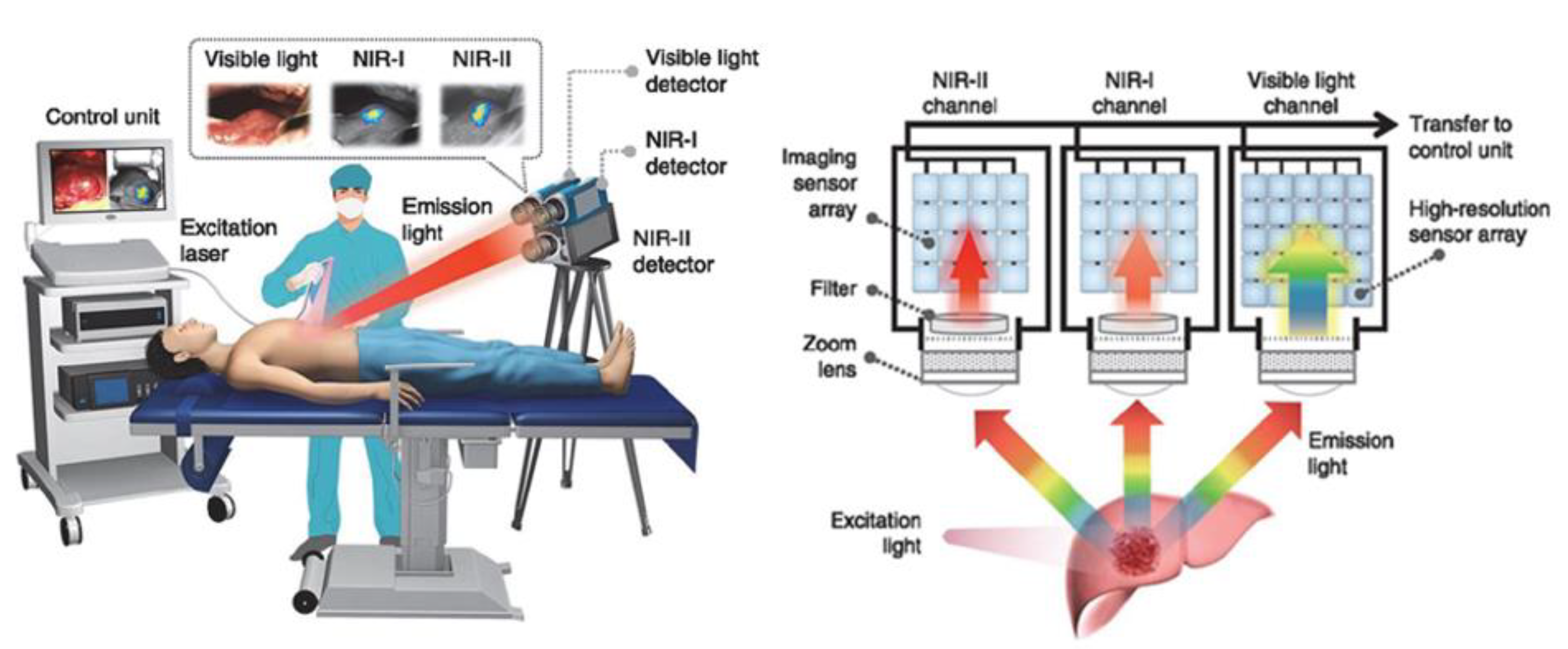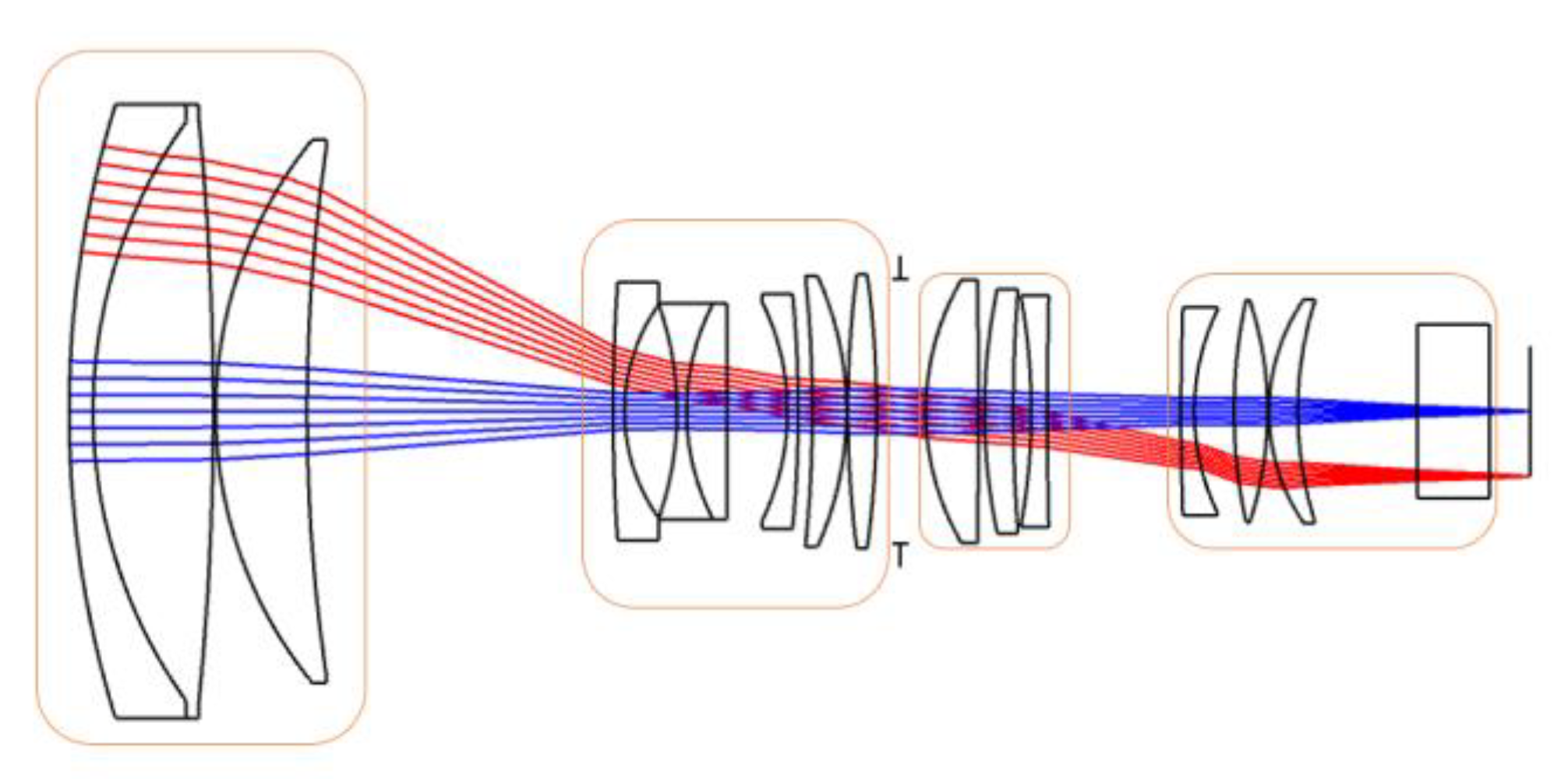Design of Zoom Optical System from Visible to NIR-II for Vivo Fluorescence Imaging Device
Abstract
1. Introduction
2. Design Strategy
2.1. Zoom System Principle
2.2. Elimination of Wide Band Chromatic Aberration
2.3. Athermal Design
3. Optical Design and Optimization
3.1. Initial Structure Selection
3.2. Optical System Optimization
4. Results
4.1. The Layout and Aberration Diagrams of Optical System
4.2. Analysis of Tolerance
4.3. Zoom Curve
5. Conclusions
Author Contributions
Funding
Institutional Review Board Statement
Data Availability Statement
Acknowledgments
Conflicts of Interest
References
- Wang, T.; Wang, S.; Liu, Z.; He, Z.; Yu, P.; Zhao, M.; Zhang, H.; Lu, L.; Wang, Z.; Wang, Z.; et al. A hybrid erbium(III)–bacteriochlorin near-infrared probe for multiplexed biomedical imaging. Nat. Mater. 2021, 20, 1571–1578. [Google Scholar] [CrossRef] [PubMed]
- Hu, Z.; Fang, C.; Li, B.; Zhang, Z.; Cao, C.; Cai, M.; Su, S.; Sun, X.; Shi, X.; Li, C.; et al. First-in-human liver-tumour surgery guided by multispectral fluorescence imaging in the visible and near-infrared-I/II windows. Nat. Biomed. Eng. 2020, 4, 259–271. [Google Scholar] [CrossRef] [PubMed]
- Zhang, B.; Gao, F.; Wang, M.; Cao, X.; Liu, F.; Wang, X.; Luo, J.; Wang, G.; Bai, J. In vivo tomographic imaging of lung colonization of tumour in mouse with simultaneous fluorescence and X-ray CT. J. Biophotonics 2014, 7, 110–116. [Google Scholar] [CrossRef] [PubMed]
- Nguyen, Q.T.; Olson, E.S.; Aguilera, T.A.; Jiang, T.; Scadeng, M.; Ellies, L.G.; Tsien, R.Y. Surgery with molecular fluorescence imaging using activatable cell-penetrating peptides decreases residual cancer and improves survival. Proc. Natl. Acad. Sci. USA 2010, 107, 4317–4322. [Google Scholar] [CrossRef] [PubMed]
- Anderson, R.R.; Parrish, J.A. The optics of human skin. J. Invest. Dermatol. 1981, 77, 13–19. [Google Scholar] [CrossRef] [PubMed]
- Li, X.; Gong, H.-M.; Shao, X.M.; Li, T.; Huang, S.-L.; Ma, Y.-J.; Yang, B.; Zhu, X.-L.; Gu, Y.; Fang, J.-X. Recent advances in short wavelength infrared InGaAs focal plane arrays. J. Infrared Millim. Waves 2022, 41, 009. [Google Scholar]
- Ronald, G.D.; Hodgkin, V.; Richard, V. What good is SWIR? Passive day comparison of VIS, NIR, and SWIR. SPIE 2013, 8706, 87060L. [Google Scholar]
- Hodgkin, V.A.; Hixson, J.G.; Corbin, T.; Armentrout, W.P. Impact of waveband on target-to-background contrast of camouflage. SPIE 2012, 8355, 835519. [Google Scholar]
- Tamagawa, Y.; Tajime, T. Dual-band optical systems with a projective athermal chart: Design. Appl. Opt. 1997, 36, 297–301. [Google Scholar] [CrossRef] [PubMed]
- Allied Vision, Goldeye Cl-130-Tec1datasheet [OE/EB]. Available online: https://cdn.alliedvision.com/fileadmin/pdf/en/Goldeye_CL-130_TEC1_DataSheet_en.pdf (accessed on 15 December 2022).
- Chunkan, T. Design of Zoom Optical System; National Defense Industry Press: Dublin, OH, USA, 1988. [Google Scholar]
- Kingslake, R.; Johnson, R.B. Lens Design Fundamentals; Academic Press: Burlington, VT, USA, 2010; pp. 137–167. [Google Scholar]
- Joseph, M.G. Introduction to Lens Design with Practical ZEMAX Examples; Willmann-Bell Inc.: Richmond, VA, USA, 2002; pp. 175–205. [Google Scholar]
- Christopher, C.A. Multi spectral infrared imaging optics. SPIE 2003, 5074, 830–838. [Google Scholar]
- Wang, Z.; Gu, P. Practical Optical Technology Handbook; Machinery Industry Press: Beijing, China, 2006; pp. 333–415. [Google Scholar]
- Ozawa, T. Compact Zoom Lens. U.S. Patent 4699474-A, 13 October 1987. [Google Scholar]
- Miks, A.; Novak, J. Paraxial analysis of zoom lens composed of three tunable-focus elements with fixed position of image-space focal point and object-image distance. Opt. Express 2014, 22, 27056–27062. [Google Scholar] [CrossRef] [PubMed]
- Zhang, K.; Zhong, X.; Zheng, Q.; Meng, Y.; Su, Z.Q. Design method research of a radiation-resistant zoom lens. Opt. Commun. 2022, 509, 127881. [Google Scholar] [CrossRef]






| Material | Refractive Index | Chromatic Dispersion | |||||
|---|---|---|---|---|---|---|---|
| n0.55 μm | n0.85 μm | n1.35 μm | C0.4–0.7 μm | C0.7–1.0 μm | C1.0–1.7 μm | C0.4–1.7 μm | |
| N-BK7 | 1.51852 | 1.50986 | 1.50322 | 3.42% | 1.08% | 1.70% | 3.00% |
| N-PK52A | 1.49830 | 1.49184 | 1.48750 | 2.70% | 0.81% | 1.05% | 2.20% |
| N-SF1 | 1.72308 | 1.69889 | 1.68900 | 7.70% | 1.85% | 2.50% | 12.30% |
| N-LAF2 | 1.74753 | 1.73074 | 1.72146 | 5.05% | 1.32% | 1.32% | 3.57% |
| N-LAF34 | 1.77582 | 1.75965 | 1.74921 | 14.50% | 1.28% | 1.63% | 3.50% |
| Parameters | Values |
|---|---|
| Focal length | 25–150 mm |
| f-number | 5.0–6.0 |
| Working spectrum | 400–1700 nm |
| Full field of view | 3.1–18.6° |
| Distortion | ≤3% |
| MTF(100 lp/mm) | ≥0.3 |
| ELEM (S1–S2) | EFFL/mm | l/mm | l’/mm | Power/mm−1 |
|---|---|---|---|---|
| (1–2) | −838.908988 | 856.928146 | −830.307019 | −0.001192 |
| (2–3) | 509.499515 | −501.816581 | 463.792934 | 0.001963 |
| (4–5) | 649.766047 | −661.913398 | 598.462667 | 0.001539 |
| (6–7) | −188.382558 | 193.390036 | −187.898733 | −0.005308 |
| (8–9) | −134.445631 | 136.704320 | −136.088199 | −0.007438 |
| (9–10) | 203.022051 | −203.075034 | 187.508803 | 0.004926 |
| (11–12) | −369.991328 | 368.785954 | −375.935497 | −0.002703 |
| (13–14) | 517.164067 | −497.424250 | 522.149309 | 0.001934 |
| (15–16) | 611.601289 | −605.083551 | 605.468528 | 0.001635 |
| (18–19) | 340.996070 | −340.135662 | 317.624498 | 0.002933 |
| (20–21) | 1269.725526 | −1277.621807 | 1248.774261 | 0.000788 |
| (22–23) | −479.887421 | 480.615973 | −485.336322 | −0.002084 |
| (24–25) | −219.869174 | 225.500765 | −219.419265 | −0.004548 |
| (26–27) | 213.582213 | −205.255629 | 207.937765 | 0.004682 |
| (28–29) | 403.404418 | −416.395251 | 379.400041 | 0.002479 |
| (30–31) | Infinity | 0.000000 | 0.000000 | 0.000000 |
| Group | 1 | 2 | 3 | 4 |
|---|---|---|---|---|
| Initial EFL/mm | 117.64 | −70.14 | 42.87 | −140.34 |
| Final EFL/mm | 124.385 | −78.783 | 42.717 | −182.017 |
| Distance | d12 | d23 | d34 | d4f |
|---|---|---|---|---|
| Short focal length/mm | 0.2 | 80.15 | 4.71 | 17.526 |
| Long focal length/mm | 65.47 | 15.175 | 12.883 | 27.116 |
Disclaimer/Publisher’s Note: The statements, opinions and data contained in all publications are solely those of the individual author(s) and contributor(s) and not of MDPI and/or the editor(s). MDPI and/or the editor(s) disclaim responsibility for any injury to people or property resulting from any ideas, methods, instructions or products referred to in the content. |
© 2023 by the authors. Licensee MDPI, Basel, Switzerland. This article is an open access article distributed under the terms and conditions of the Creative Commons Attribution (CC BY) license (https://creativecommons.org/licenses/by/4.0/).
Share and Cite
Guo, S.; Fang, L.; Chen, F. Design of Zoom Optical System from Visible to NIR-II for Vivo Fluorescence Imaging Device. Appl. Sci. 2023, 13, 1421. https://doi.org/10.3390/app13031421
Guo S, Fang L, Chen F. Design of Zoom Optical System from Visible to NIR-II for Vivo Fluorescence Imaging Device. Applied Sciences. 2023; 13(3):1421. https://doi.org/10.3390/app13031421
Chicago/Turabian StyleGuo, Shuaicheng, Lu Fang, and Fuchun Chen. 2023. "Design of Zoom Optical System from Visible to NIR-II for Vivo Fluorescence Imaging Device" Applied Sciences 13, no. 3: 1421. https://doi.org/10.3390/app13031421
APA StyleGuo, S., Fang, L., & Chen, F. (2023). Design of Zoom Optical System from Visible to NIR-II for Vivo Fluorescence Imaging Device. Applied Sciences, 13(3), 1421. https://doi.org/10.3390/app13031421






